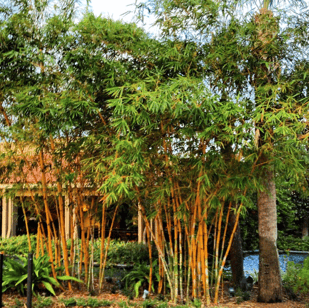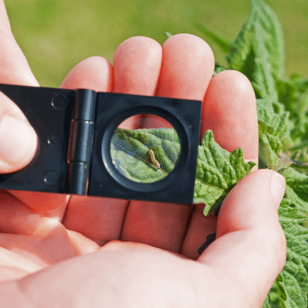
Home / Here on Earth / Five Costliest Lawn and Landscape Myths
Like most things in life, landscaping is complicated. In fact, a majority of colleges and universities offer turf management, landscape science, or plant health programs specifically designed to create landscape professionals. From practical skills like time management and planning to scientific processes like horticulture and ecology, proper landscape practices aren’t just made up on the fly (or at least, they shouldn’t be). In order to properly maintain even the smallest of landscapes, a variety of skills and specialized practices are necessary, despite what you may have heard to the contrary.
Why Lie About Landscape?
In the past, the complicated nature of Landscape Science has left it of little interest to the public. But as our cities expand and the landscape becomes more accessible and more advanced, at home or do-it-yourself landscaping practices, and misconceptions, have taken off.
Unlike a dedicated and certified landscaper, the average property manager or homeowner probably doesn’t consult a scholarly publication or accredited institution before starting a DIY landscape project, and worse, consider it a chore. As such, many cut corners in an attempt to save on time and money, but end up costing themselves in repairs, replants, and entire restorations. To try and prevent the costliest, and most ecologically damaging practices, we have assembled a list of the most common landscape myths.
Lawn and Landscape Myths
.jpg?width=400&height=297&name=DTEL-%20Blog%20(26).jpg)
Mowing Shorter Is Mowing Better
This misconception comes from a lack of understanding when it comes to both plant health and turfgrass management. Not only is there a recommended length for grass to be cut to, but this length varies based on species and subspecies of grass. A lawn that is cut too short can become stressed from excessive sunlight and exposed roots, as well as more susceptible to diseases and pests. This can lead to brown spots, pest infestation, and optimal conditions for weed growth.
Watering at Night Saves Money and Water
This is an example of a myth that attempts to justify itself with science but misses the mark completely. The myth goes that watering during the day causes excess water to evaporate in the sun, instead of being absorbed by the plants. Therefore, watering your lawn at night will prevent this evaporation, allowing you to water less and save more
-compressed-jpg.jpeg?width=407&height=225&name=DTELandscape1%20(2)-compressed-jpg.jpeg)
While the sun does cause evaporation, this process is much slower than the myth suggests. Healthy root systems will begin absorption almost immediately after a watering. Any excess water that is not absorbed or drained is evaporated after a couple of hours.
Let’s start with the premise of this one.
If you water your lawn at night, this excess water sits on top of your turfs root systems which have already drank their fill. This additional moisture buildup can weaken root system and make your lawn susceptible to fungus, mildew, and disease. In extreme cases of overwatering, your lawn may be past saving, and require an entire turf replacement.
All Plants Need Direct Sunlight

When it comes to plants, there is no such thing as “all”. Every single plant is unique, down to the sub-species, and this means all care requirements are different, even sunlight exposure. Depending on the plant's native habitat, they will have evolved to withstand certain conditions, and are unprepared for others. With aesthetic on the forefront of customers minds when building a landscape, nonnative plants end up being some of the more beloved landscape enhancements.
Peonies, bamboo, and even lilies are some of the most common decorative additions in Florida, but none of them are native. Delicate flowers like peonies have chilling requirements and will wilt and die if they receive too much sun during the summer. Bamboo, despite common misconceptions, is also not a fan of direct sunlight. In bamboos natural environment, other tall trees filter sunlight down into the bamboo. Direct sun can cause the delicate shoots and leaves to dehydrate and burn.
Store Bought Pesticides are Effective Pest Management

A lot of homeowners and property managers have fallen into a pest management practice known humorously as “Spraying and Praying”. Stemming from both fear and laziness, store bought pesticides tend to be carelessly and excessively applied, and this is typically only done when a pest is visible or bothersome. Not only can excessive and untrained application of chemicals cause environmental problems, but health problems in humans and pets alike.
Professionals who apply pesticides are required to attend courses, pass tests, and receive certifications before they are even allowed to preform chemical applications. Even then, the most informed professionals’ practice Integrated Pest Management, which relies less on chemicals and more on natural alternatives and cultural changes.
Landscape Services are Costly and Unnecessary
Despite the growing acceptance of Plant Health, Turf Management, and Landscape Science as respected disciplines, humans will always try to cut corners. Although most people can successfully plant shrubs or mow their lawn, the actual process of landscaping transcends these smaller practices. As of 2018 the United States has over half a million landscape service providers employing over one million Americans.
With landscape services becoming more accepted, finding a trusted landscape provider becomes another task. Always look for providers and professionals who have received certifications and licenses to perform the work you need done.
Sticking to good landscaping maintenance and method is challenging, and fitting landscape services into your budget can be tricky. Yet, the feeling of having a well-maintained beautiful landscape makes up for the challenges experienced in yard maintenance. If you’re considering landscaping services, consider Down To Earth Landscape & Irrigation for professional services that won’t break the bank.

.png?width=680&height=227&name=Untitled%20design%20(9).png)